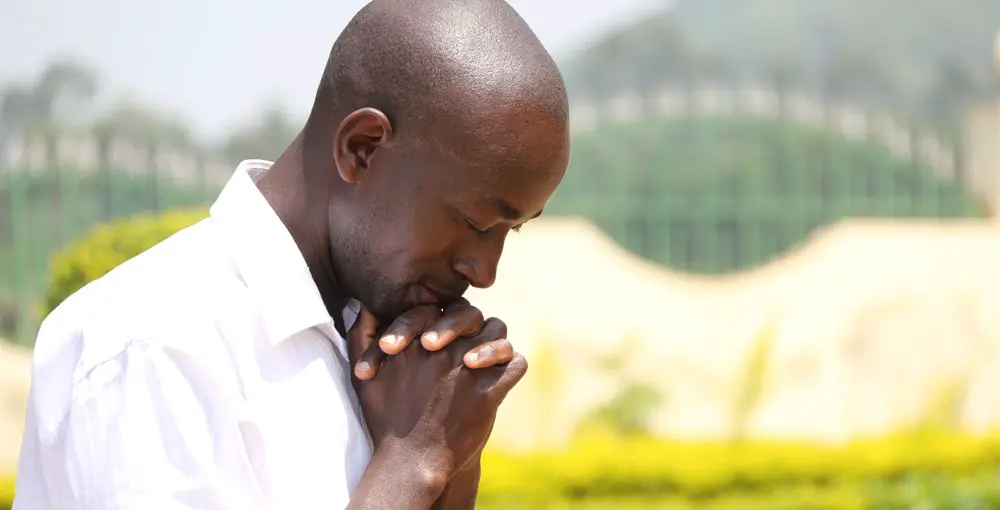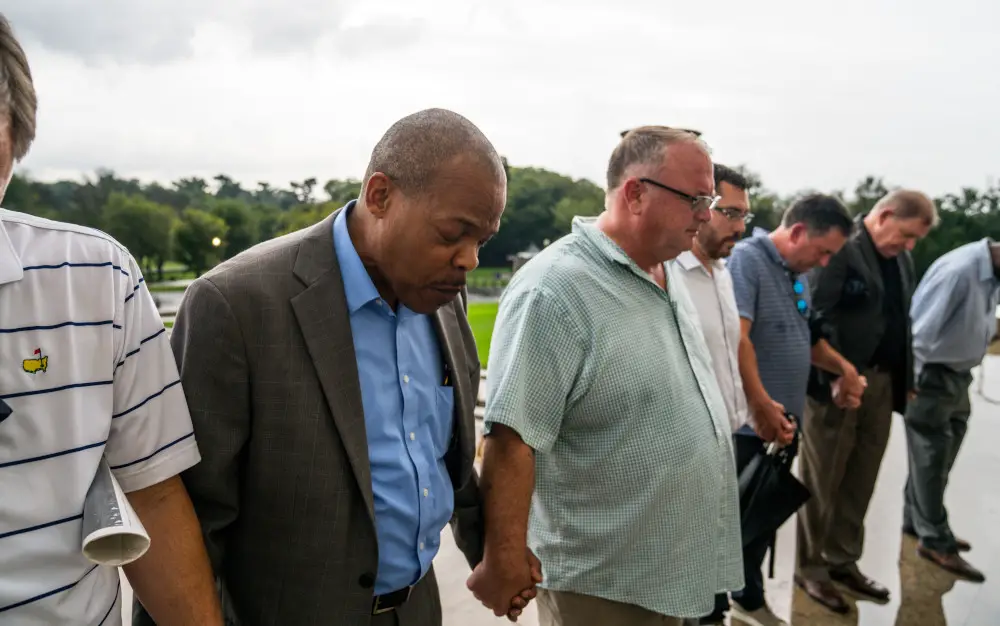Lucas stood at the edge of the cliff, his heart heavy with years of unresolved conflict. As the sun dipped below the horizon, painting the sky in hues of orange and pink, he closed his eyes and whispered a prayer.
It wasn’t just any prayer; it was a prayer of reconciliation. Beginning from that moment, Lucas embarked on a journey that would not only mend his broken relationships but also bring him closer to God than he had ever been before.
Like Lucas, many of us carry the weight of broken relationships, misunderstandings, and spiritual disconnection.
The prayer of reconciliation offers a powerful solution to these burdens, paving the way for healing, unity, and spiritual growth.
Key Takeaways
- Prayer of reconciliation is a powerful tool for healing relationships and drawing closer to God.
- Biblical foundations emphasize our role in the ministry of reconciliation.
- Effective reconciliation prayer involves humility, forgiveness, faith, and persistence.
- Practical steps include self-reflection, confession, forgiveness, intercession, and action.
- Community support and overcoming personal challenges are crucial in the reconciliation journey.
Understanding the Prayer of Reconciliation

At its core, the prayer of reconciliation is a heartfelt plea to God for restoration – both in our relationship with Him and with others. It acknowledges our need for divine intervention to bridge the gaps that human efforts alone cannot span.
James 5:16 (ESV) beautifully captures the essence of this prayer:
“Therefore, confess your sins to one another and pray for one another, that you may be healed. The prayer of a righteous person has great power as it is working.”
This verse highlights two crucial aspects of reconciliation prayer:
- The power of confession.
- The effectiveness of righteous prayer.
The Biblical Foundation of Reconciliation Prayer

The concept of reconciliation is deeply rooted in biblical teachings. Jesus Christ, through His sacrifice on the cross, became the ultimate reconciler between God and humanity. As followers of Christ, we are called to embody this spirit of reconciliation in our lives.
2 Corinthians 5:18-19 (NIV) states,
“18 All this is from God, who reconciled us to himself through Christ and gave us the ministry of reconciliation: 19 that God was reconciling the world to himself in Christ, not counting people’s sins against them. And he has committed to us the message of reconciliation.”
This passage emphasizes our role as ambassadors of reconciliation, reflecting God’s love and forgiveness in our interactions with others.
Key Principles of Effective Reconciliation Prayer

- Humility: Approaching God and others with a humble heart is essential. Proverbs 11:2 (NIV) reminds us, “When pride comes, then comes disgrace, but with humility comes wisdom.”
- Forgiveness: At the heart of reconciliation lies forgiveness. As Jesus taught in Matthew 6:14-15 (NIV), “14 For if you forgive other people when they sin against you, your heavenly Father will also forgive you. 15 But if you do not forgive others their sins, your Father will not forgive your sins.”
- Faith: Believing in God’s power to heal and restore is crucial. Mark 11:24 (NIV) encourages us, “Therefore I tell you, whatever you ask for in prayer, believe that you have received it, and it will be yours.”
- Persistence: Sometimes, reconciliation is a process that requires ongoing prayer and effort. Luke 18:1 (NIV) advises us to “always pray and not give up.”
Practical Steps for Engaging in Reconciliation Prayer
- Self-reflection: Begin by examining your own heart and actions. Ask God to reveal areas where you may have contributed to the conflict.
- Confession: Confess your faults to God and, when appropriate, to the person you’re seeking reconciliation with.
- Forgiveness: Extend forgiveness to those who have hurt you, even if they haven’t asked for it.
- Intercession: Pray for the other person’s well-being and for God to soften both your hearts.
- Action: Be willing to take practical steps towards reconciliation.
The Life-changing Power of Reconciliation Prayer

When we engage in sincere prayer for reconciliation, we open ourselves to God’s life-changing power. This can lead to:
- Emotional healing.
- Restored relationships.
- Deepened faith.
- Greater empathy and understanding.
- A stronger sense of community.
Personal Testimonies: Stories of Reconciliation
Lucas’s story, which we began with, didn’t end on that cliff. Through persistent prayer and a willingness to reach out, he reconciled with his estranged sister after years of silence. Their renewed relationship became a testament to the power of reconciliation prayer.
Another inspiring example is that of John Mwangi, a church leader in Nairobi, who found himself at odds with a fellow pastor. Through dedicated prayer and humble communication, they not only resolved their differences but also strengthened their church community in the process.
Overcoming Challenges in Reconciliation Prayer
While the journey of reconciliation can be rewarding, it’s not without challenges. Here are some common obstacles and how to address them through prayer:
- Pride: Ask God to humble your heart and help you see beyond your own perspective.
- Fear: Pray for courage and trust in God’s guidance through the reconciliation process.
- Unforgiveness: Seek God’s help in releasing bitterness and embracing forgiveness, even when it feels impossible.
- Lack of communication: Ask for wisdom in finding the right words and the right time to initiate reconciliation.
The Role of Community in Reconciliation Prayer

While reconciliation often feels like a personal journey, the support of a faith community can be invaluable. James 5:16 encourages us to “pray for one another.” Consider:
- Joining a prayer group focused on reconciliation.
- Seeking guidance from spiritual mentors.
- Participating in community reconciliation efforts.
Reconciliation Prayer in Different Contexts
The principles of reconciliation prayer can be applied in various settings:
- Personal relationships: Family conflicts, friendships, and romantic partnerships.
- Workplace: Colleague disputes, and employee-employer relations.
- Church: Denominational differences, and congregational conflicts.
- Societal: Racial or tribal reconciliation, and community divisions.
Conclusion
In conclusion, the prayer of reconciliation is a powerful instrument of healing and unity. As we embrace this practice, we not only mend our earthly relationships but also draw closer to the heart of God.
Let us heed the call to be ambassadors of reconciliation, bringing hope and restoration to a world in need of unity and peace.
Frequently Asked Questions
Q. What is a prayer of reconciliation?
A. A prayer of reconciliation is a heartfelt plea to God for restoration of relationships, both with Him and with others. It involves seeking forgiveness, extending forgiveness, and asking for God’s intervention in healing broken relationships.
Q. How can I start praying for reconciliation?
A. Begin by examining your own heart, confessing any faults to God, and asking for His guidance. Pray for the person you seek reconciliation with, asking God to soften both your hearts and provide opportunities for healing.
Q. Can reconciliation prayer help in non-religious conflicts?
A. Yes, the principles of reconciliation prayer can be applied to any conflict situation. Even in non-religious contexts, the practices of self-reflection, forgiveness, and seeking peace can be powerful tools for resolution.
Q. What if the other person doesn’t want reconciliation?
A. Continue to pray for them and the situation. Focus on your own heart and actions, leaving the results to God. Sometimes, reconciliation is a long process that requires patience and persistent prayer.
Q. How often should I pray for reconciliation?
A. There’s no set frequency, but consistency is key. Make it a regular part of your prayer life, especially when actively working towards reconciliation in a specific relationship.






